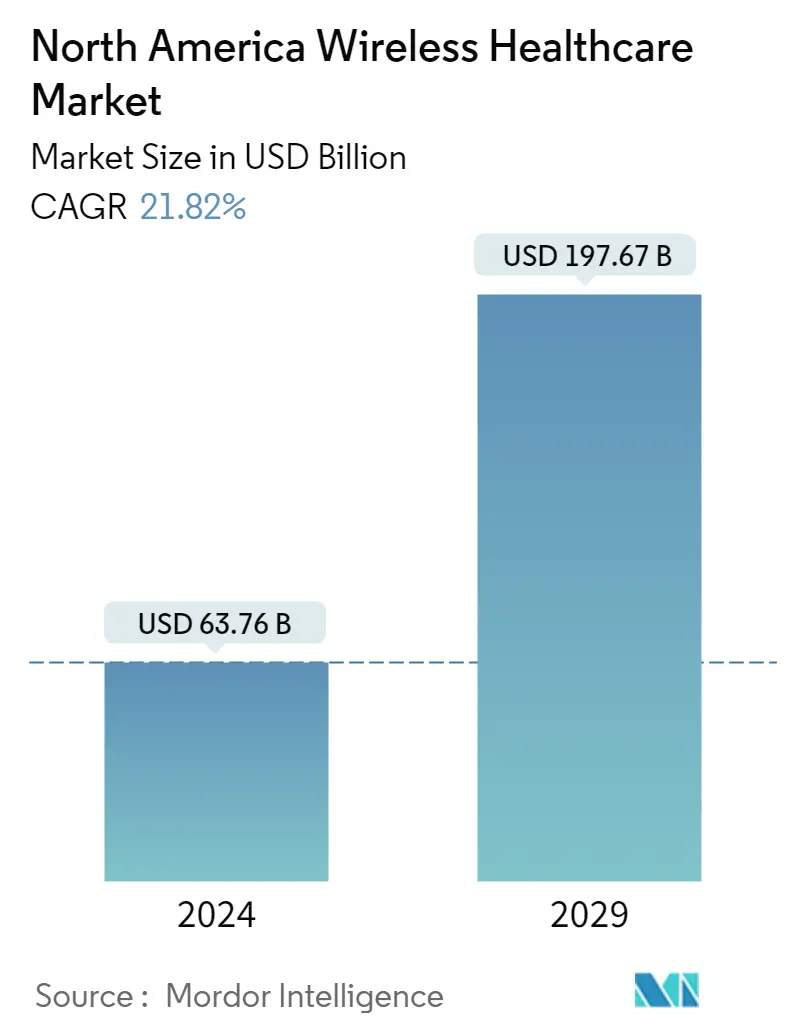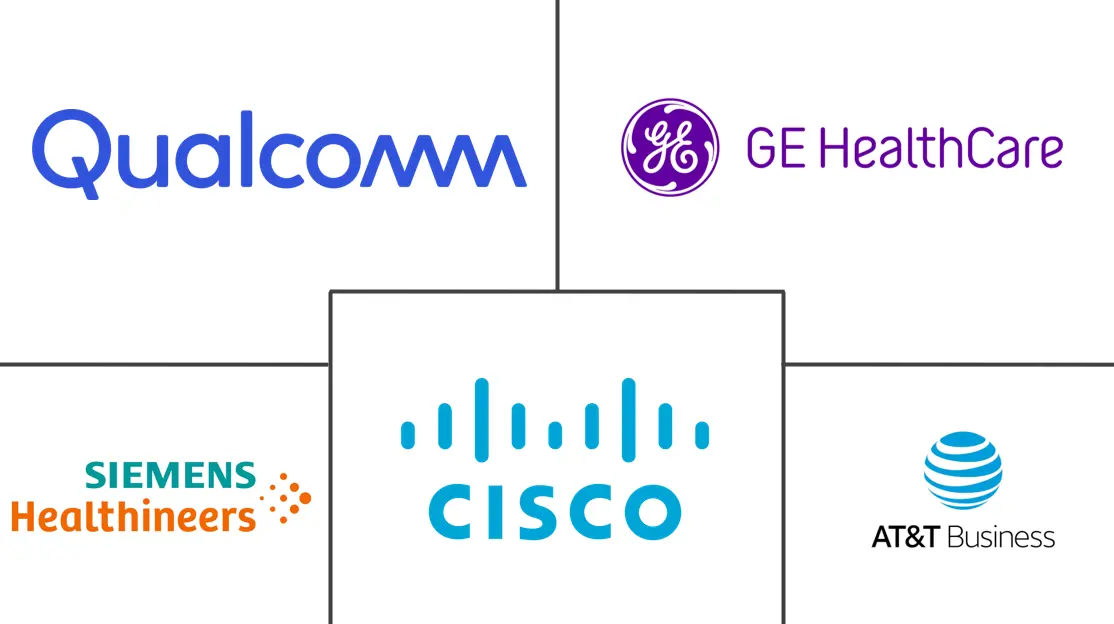Market Size of North America Wireless Healthcare Industry

| Study Period | 2019 - 2029 |
| Base Year For Estimation | 2023 |
| Market Size (2024) | USD 63.76 Billion |
| Market Size (2029) | USD 197.67 Billion |
| CAGR (2024 - 2029) | 21.82 % |
| Market Concentration | Medium |
Major Players
*Disclaimer: Major Players sorted in no particular order |
North America Wireless Healthcare Market Analysis
The North America Wireless Healthcare Market size is estimated at USD 63.76 billion in 2024, and is expected to reach USD 197.67 billion by 2029, growing at a CAGR of 21.82% during the forecast period (2024-2029).
- The demand for remote patient monitoring (RPM) solutions is anticipated to rise due to the increased prevalence of chronic diseases, the aging population, and the need to reduce healthcare costs. Wireless devices and wearables that monitor patients' essential signs and health metrics remotely can lead to the early detection of health issues and enhance patient outcomes.
- Wireless radio frequency identification (RFID) technology also allows hospitals to track the real-time location of critical equipment and the condition of the equipment. The Shands Hospital in Florida experienced a 98.8% reduction in the hours spent searching for missing items by adopting wireless technology.
- There is an increased number of services and applications associated with the Internet of Things (IoT) across different end-user industry disciplines. IoT has evolved from RFID and wireless sensor network (WSN) technologies to more advanced technology, with the integration of cloud computing, Internet services, cyber-physical systems, and interconnections between hardware and software devices. Machine learning (ML) and AI capabilities are taking their skills to the next level, especially in the current healthcare industry.
- A worldwide shortage of healthcare workers is another parameter influencing the market dynamics. For instance, the United States alone is projected to face a shortage of 124,000 physicians by 2025, which is much less than the anticipated shortages in Asian and African regions. These factors indicate the need for upgraded medical facilities and improvement in the healthcare sector, which, in turn, is expected to drive the market, as advanced and connected medical equipment is likely to experience more demand.
- The development of the wireless healthcare industry has been significantly supported by ongoing developments in wireless communication technologies, such as 5G, the Internet of Things, edge computing, and artificial intelligence (AI). These technologies can enable faster and more reliable data transmission, real-time monitoring, and advanced analytics, enhancing healthcare delivery and patient outcomes.
- However, collecting, transmitting, and storing sensitive patient data through wireless healthcare technologies might raise significant concerns about data security and patient privacy. Breaches or unauthorized access to patient information can weaken trust and hinder the adoption of wireless healthcare solutions.
North America Wireless Healthcare Industry Segmentation
Wireless healthcare can integrate wireless communication technologies and devices into the healthcare industry to enable the remote monitoring, diagnosis, treatment, and management of patients' health and medical conditions.
The North America wireless healthcare market is segmented by component (hardware and software, services), application (hospitals and nursing homes, home care, and pharmaceuticals), and geography (United States, Canada).
The market sizes and forecasts are provided in terms of value in USD for all the above segments.
| Component | |
| Hardware | |
| Software | |
| Services |
| Application | |
| Hospitals and Nursing Homes | |
| Home Care | |
| Pharmaceuticals |
| Geography | |
| United States | |
| Canada |
North America Wireless Healthcare Market Size Summary
The North American wireless healthcare market is poised for significant growth, driven by advancements in wireless communication technologies such as 5G, IoT, edge computing, and AI. These technologies facilitate faster data transmission, real-time monitoring, and advanced analytics, which are crucial for enhancing healthcare delivery and patient outcomes. The increasing prevalence of chronic diseases, an aging population, and the need to reduce healthcare costs are fueling the demand for remote patient monitoring solutions. Additionally, the integration of wireless RFID technology in hospitals improves operational efficiency by enabling real-time tracking of equipment. The market is also influenced by a shortage of healthcare workers, particularly in the United States, which underscores the need for upgraded medical facilities and advanced medical equipment.
The market landscape is characterized by a moderate level of concentration, with established global players and emerging startups contributing to its dynamism. The United States, in particular, is at the forefront of this revolution, supported by its robust healthcare infrastructure and strategic investments in digital health. The country hosts a vibrant ecosystem of stakeholders, including healthcare providers, technology companies, and regulators, which accelerates the adoption of wireless healthcare solutions. Startups are increasingly focusing on telehealth platforms and remote monitoring solutions, attracting significant investments that drive innovation and market expansion. Partnerships and collaborations among key players, such as Siemens Healthineers and Atrium Health, further enhance the market's growth trajectory by leveraging cutting-edge technologies and expanding service offerings.
North America Wireless Healthcare Market Size - Table of Contents
-
1. MARKET INSIGHTS
-
1.1 Market Overview
-
1.2 Industry Value Chain Analysis
-
1.3 Industry Attractiveness - Porter's Five Forces Analysis
-
1.3.1 Bargaining Power of Suppliers
-
1.3.2 Bargaining Power of Buyers/Consumers
-
1.3.3 Threat of New Entrants
-
1.3.4 Threat of Substitute Products
-
1.3.5 Intensity of Competitive Rivalry
-
-
1.4 Assessment of the Impact of COVID-19 on the Market
-
-
2. MARKET SEGMENTATION
-
2.1 Component
-
2.1.1 Hardware
-
2.1.2 Software
-
2.1.3 Services
-
-
2.2 Application
-
2.2.1 Hospitals and Nursing Homes
-
2.2.2 Home Care
-
2.2.3 Pharmaceuticals
-
-
2.3 Geography
-
2.3.1 United States
-
2.3.2 Canada
-
-
North America Wireless Healthcare Market Size FAQs
How big is the North America Wireless Healthcare Market?
The North America Wireless Healthcare Market size is expected to reach USD 63.76 billion in 2024 and grow at a CAGR of 21.82% to reach USD 197.67 billion by 2029.
What is the current North America Wireless Healthcare Market size?
In 2024, the North America Wireless Healthcare Market size is expected to reach USD 63.76 billion.

